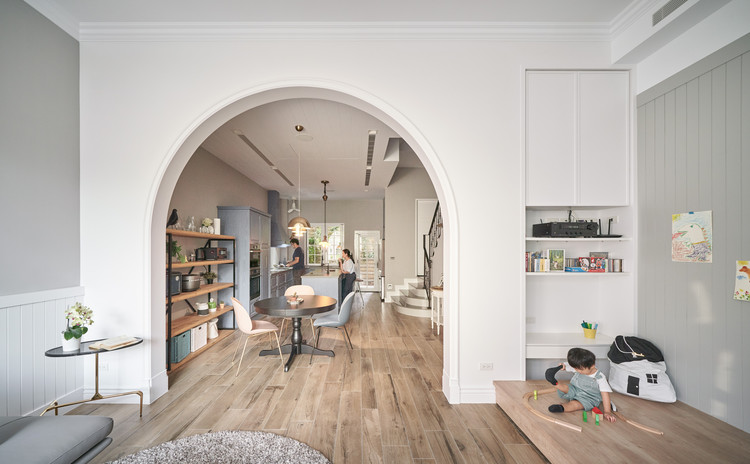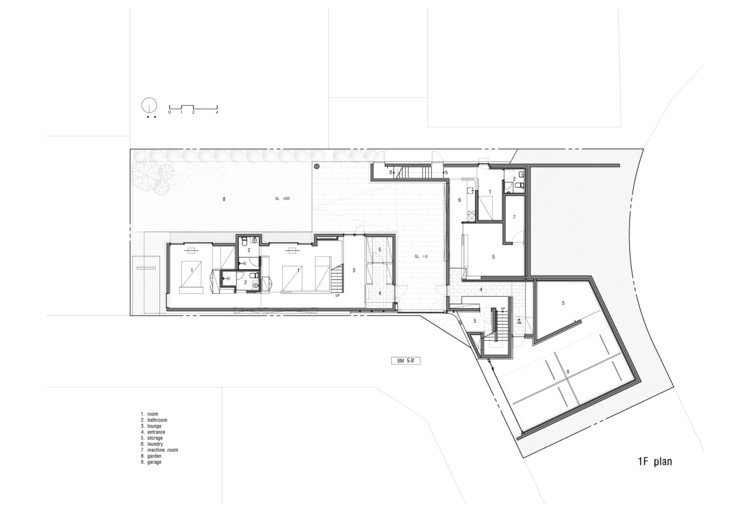Blind Whale Z_Lab
2015-09-28 19:00
架构师提供的文本描述。“盲鲸”项目调查了济州岛特有的乔-川的价值。乔-川指的是一种地方感,而“盲鲸”则是通过维护曾经由渔网制成的圆形屋顶来实现这一点的。
Text description provided by the architects. The ‘Blind Whale' project investigates the value of Jo-cheon that is unique to Jeju Island. Jo-cheon refers to a sense of place and ‘Blind Whale’ achieves this by maintaining the round shaped roof that was once made of fishing nets.
© Kim Jae-kyeong
金


这种屋顶是济州农舍独有的特色。乔川村建于大约800年前,也就是十四世纪初。当地人认为这是一个等待的地方,那里微风轻拂着人们驶往大陆的船只。乔金,也举行了一个具有战略意义的地点。
This type of roof is a feature unique to Jeju farm houses. Jo-cheon village was settled about 800 years ago, in the early fourteenth century. It was considered by the locals as a waiting place where the mild winds gently blew ships of people headed for the mainland. Jocheon, also held a strategically significant location.
Perspective


从朝鲜王朝到朝鲜王朝时期,济州岛被用作流亡者。那些被流放的人聚集在约川,那里离他们的家人和国王居住的大陆稍微近一些。
From the Korea Dynasty to Joseon Dynasty period, Jeju island was used for exiles. Those who were exiled came together at Jocheon, a locations slightly closer to mainland where their family and the king lived.
© Kim Jae-kyeong
金


一座石屋,可以俯瞰乔川村中央的延布宫(延布亭),被认为能给住在里面的人带来好运。据乔金居民说,这座石屋已经建了一百多年了。
A stone house that overlooks the Yeon-buk-jung (Yeon-buk pavilion) in the middle of Jocheon village is considered to bring luck to those who reside in it. According to the Jocheon residents, this stone house has stood for over a hundred years.
Floor Plan


更有趣的是,这座石屋的形状。圆形屋顶看起来像鲸鱼。它是用网编织的,用石头锚定下来,这样风就不会把它吹掉。我们以据信埋在海里的“盲鲸”命名。屋顶看上去就像两只鲸鱼,它们漂流在远离大海的地方,被冲上了陆地。
What’s more interesting, is shape of this stone house. The rounded roof looks like whale. It was weaved from nets and anchored down using stones so the wind wouldn’t blow it off. We named it after the ‘Blind Whale' which believed to be buried in the sea. The roof looks like two whales that have drifted far from the sea and washed up on the land.
© Kim Jae-kyeong
金


为了与“盲鲸”的名称保持一致,该项目的目的是保留地点感和地点必须提供的现有材料。过去,乔川人渴望从这里到大陆旅行,但现在许多人渴望从大陆来到济州岛。我们也是陆地上的人,鉴于这一点,只有圆形的屋顶和墙壁让我们感觉到济州岛本身的敏感性。
In keeping with the name ‘Blind Whale’, the aim of the project was to retain the sense of place and existing materials the location had to offer. In the past, the Jo-cheon people aspired to travel from here to the mainland but now many people long to come froçm the mainland to Jeju. We also people on land, in view of this, only rounded roof and walls made us feel like Jeju Island sensibility itself.


为了促进生态旅游,在当地的投入和指导下,建立了一个项目,使盲鲸能够与环境和社区共存。我们这样做的一种方法是保持建筑物的原有大小和形状,只提供私人租房。
In an effort to promote eco-tourism, a program was set up with local input and guidance so that Blind Whale can coexist with the environment and community. One way in which we did this was by maintaining the original size and shape of the building and only offering lodging though private rental.
© Kim Jae-kyeong
金


我们希望强调的家庭的要素是圆形屋顶,石墙和花园之间的两座石屋。为了保持原状,我们降低了楼层水平。并保持济州岛石屋,低高度和巨石墙。我们安装了一个窗口来打开海景。
The elements of the home we wished to put emphasis on were the rounded roof, stone walls and garden between the two stone houses. To preserve original state, we lowered floor level. And keep a Jeju stone house, low height and juju stone wall. We installed a window to open up seaward views.
© Kim Jae-kyeong
金


家庭的元素,如地板和大门,被提升成桌子,床和其他家具。我们渴望保留济州农舍的传统面貌。这方面的一个例子是内墙,它被替换为较低的墙,保持原来的设计,但使人更好的流通。
Elements of the home such as the flooring and gates were upcycled into tables, beds and other pieces of furniture. We aspired to keep the traditional aspects of a Jeju farm house. An example of this would be the inside wall which was replaced with a lower wall which kept with the original design but allowed for better circulation of people.


“盲鲸”项目是振兴济州岛传统石屋价值的成功案例。也许,通过这种重新连接和革新,今天的一代将不会感到有必要拆除旧的,开始一个新的,而是保存他们独特的遗产。这个项目也给了我们尊重遗产的特殊意义。
The ‘Blind Whale’ project was successful case in revitalizing the value of a traditional Jeju stone house. Perhaps through this reconnection and renovation today’s generation will not feel the necessity to tear down the old and start a new but rather preserve their unique heritage. This project also gave us special meaning thatimportance of respect for heritage.
© Kim Jae-kyeong
金


这个过程和最终结果让我们重新发现了这个特殊的地方和空间的价值。我们希望这一项目将为其他希望振兴传统地区的建筑师和开发人员开创先例。
The process and end result allowed us to rediscover the value of this special place and space. it is our hope that this project will establish a precedent for other architects and developers looking to revitalize traditional areas.




















































Architects Z_Lab
Location Jeju-si, South Korea
Category Houses
Architects in Charge Lee Sang-muk , Noh Kyung-rok , Park Jung-hyun
Area 100.0 sqm
Project Year 2014
Photographs Kim Jae-kyeong
























